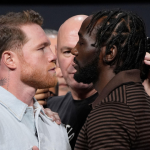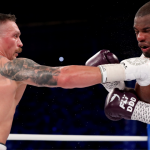EVEN in a sport as crooked and daft as boxing it is rare that you get to advertise a rematch between two undefeated fighters. If they met a first time surely someone should have gotten the better of it. But sadly when Deontay Wilder and Tyson Fury fought their much anticipated first fight back in December 2018 the only “0” that ended up going was the one both men had in the “draw” column.
So this weekend, a year and a bit on from their original bout, Wilder and Fury meet for a rematch with Wilder’s WBC heavyweight title and Fury’s invisible but still oddly respected lineal heavyweight title on the line. Questionable ruling aside, if this fight is anything like the last one we are in for a treat.
The story of the first fight was the classic tale of the boxer and the puncher. But both Fury and Wilder defy expectations. Wilder stands a towering six foot seven and can convincingly be argued to be the hardest single shot hitter in boxing history. Yet he seems to make a point of coming into his fights within dieting distance of the cruiserweight limit. Meanwhile Fury stands six foot nine but carries a more convincing heavyweight frame, weighing in at what was considered a trim 260 pounds for their first meeting. Yet it is Fury who plays the part of the crafty boxer with enough feints, misdirections and stance switches to frustrate even the great Wlad Klitschko.
The fight's on Saturday but Wilder and Fury are starting early @br_betting pic.twitter.com/8vzSWVJyAW
— Bleacher Report (@BleacherReport) February 19, 2020
Fury entered the first fight riding a streak of two so-so victories over ham-and-eggers after an almost three-year absence from the ring. Even in his world title winning performance, at the height of his powers, Fury had been difficult to watch—the Klitschko fight was painfully lacking in action. Yet when faced with a terrifying counter puncher in Deontay Wilder, Fury played a blinder. Not only did he dazzle the WBC champ with feints and have him second guessing himself, Fury committed to hitting in combination and with force. He wasn’t there to run around the outside of the ring and hold if Wilder ever got close: he was going to make a fight of it and avoid the big punches while he did so.
Wilder was not a dead duck in the first fight though. While his style is awkward and seems to revolve entirely around single shots, this awkwardness also keeps Wilder’s opponents from connecting at a good clip. While punch stats are largely overvalued, they suggested Fury and Wilder were fairly even through most of the rounds. When Wilder found his shot, it did exactly what it was advertised to: it shook Tyson Fury to his boots and Wilder went to the scorecards with two knockdowns in his favour.
But since that first fight, the two men’s careers diverged. Wilder knew that the rematch was coming, he had no mandatory challenger for his WBC belt, and he could very well have rested on his laurels waiting for that payday. Instead, Wilder took a rematch with the extremely dangerous Luis Ortiz—ranked #3 by the WBC and considered one of the most ducked heavyweights in the world.
He was also a man who had given Wilder his trickiest fight before Fury. Ortiz is a huge hitter but also has the unfair advantage that he can actually box to a very good level, and is a southpaw to boot. For each of the heavyweight champions—Wilder, Joshua and Fury—there could hardly be a less appealing fight: all risk, no reward. And yet Wilder took it anyway. Ortiz had less success than the first fight, Wilder seemed harder to hit, and it took Wilder three rounds less to catch Ortiz’s timing and knock the challenger out again.
Tyson Fury, meanwhile, took the rematch as a given and set about entertaining himself. Fury took a fight with Tom Schwarz—an unremarkable German—which no one was clamouring to see. Then Fury made a lucrative appearance in the WWE, where real sports stars are still brought in to have awkward matches that make the in-house talent look bad. And then Fury’s big tune up for Deontay Wilder was a bout with the Swedish southpaw, Otto Wallin. In that match Fury looked sluggish and sloppy. But Wallin forced a decent scrap out of Fury by slicing his eyebrow open in the early going so that Fury was forced to fight every round as if he urgently needed a knockout.
If no one else was worried by the Wallin fight, Fury certainly was. The lineal champ split with his long time trainer, Ben Davison and took up with Javan Steward, son of the legendary Emmanuel Steward. The Wallin match was in September and Fury might well have taken it lightly so there has been some time to correct course, but it should be noted that the Fury we saw against Wilder was easily the trimmest, quickest and craftiest we have seen and it was still a damn close thing.
Much of Fury’s success in the first fight was in feinting and keeping Wilder off his timing—the shoulder feints between jabs were constant, and the jabs were “snake-licked” out as Bundini Brown would say: they were loose fisted, back-handed slaps that kept Fury from committing his weight. Fury seldom stood on a line in front of Wilder in punching range, mitigating the danger of that blasting straight right—instead he stepped out the side door whenever he had thrown. And when the two ended up on the inside, Fury’s head movement and tie ups were there to complicate Wilder’s task of timing the big swing.
Convincing and frequent feints are the most important part of any fight against a counter puncher.
The problem is that all of that takes great endurance. Fury was in terrific shape before he got to the States last time around and spent the last few weeks punishing himself with training at elevation up at Big Bear. It shone through in every moment of that battle. If Fury has not recovered that kind of movement and endurance after the lackluster showing against Wallin he’s in for a long night. As Muhammad Ali said of George Foreman in the eighth round “Brother, this is the wrong place to get tired.”
Here is the intrigue of rematches: it is rarely just more of the same, they are a reunion between old sparring partners. Much of a first fight is lost feeling the opponent out and learning their habits but twelve rounds with someone really allows a fighter to get chummy. Wilder’s game is to score his earth-shattering right hand through the gaps that he finds in his opponent’s armour. Sometimes he times the right over the opponent’s jab. Other times he blasts it straight down the centre if the opponent stands still or backs straight out after an engagement. Other times he will catch fighters coming out of their combinations or the clinch with their hands down. As the champion regularly reminds us: they have to be perfect for twelve rounds, he only needs to be perfect for a second.
The difficulty with being a minimalist, single shot kind of puncher is that you aren’t using the jab, feints, ring generalship or the infight to force more openings. So if you cannot get your timing down you can look very sloppy. The early rounds of many of Wilder’s fights conjure up the image of a man who is dancing enthusiastically, but out of rhythm. That is until he can get his timing down and then he tends to end the fight in an instant.
Wilder has had only two rematches, Ortiz and Stiverne, and in both rematches Wilder massacred his man in half the time with half the trouble. Familiarity seems to help Wilder and as Fury enters his thirteenth round with the WBC champion, having been almost knocked out in the twelfth, that should be at the front of his mind.



